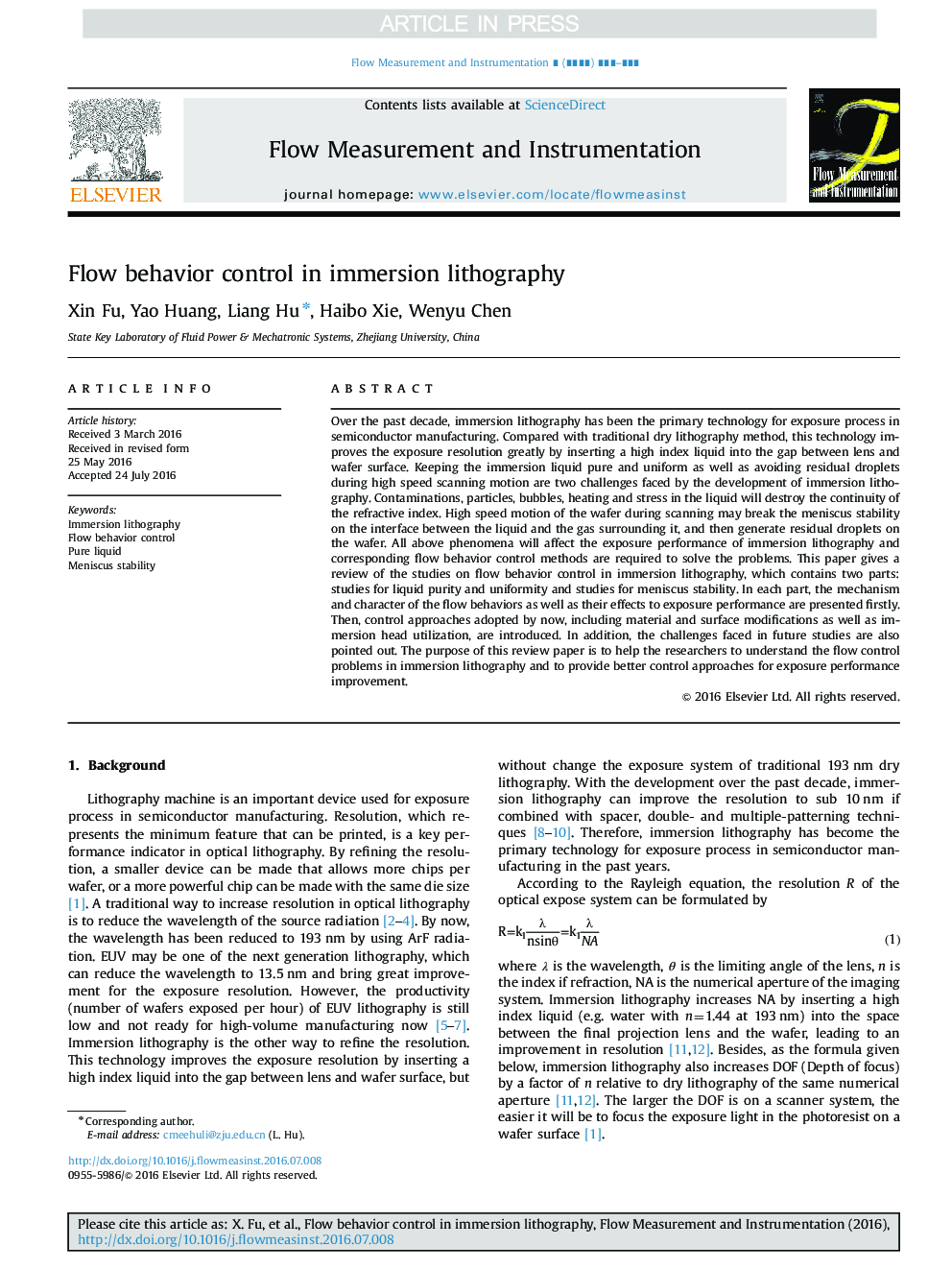| کد مقاله | کد نشریه | سال انتشار | مقاله انگلیسی | نسخه تمام متن |
|---|---|---|---|---|
| 5001908 | 1368445 | 2017 | 14 صفحه PDF | دانلود رایگان |
عنوان انگلیسی مقاله ISI
Flow behavior control in immersion lithography
ترجمه فارسی عنوان
کنترل جریان در لیتوگرافی غوطه وری
دانلود مقاله + سفارش ترجمه
دانلود مقاله ISI انگلیسی
رایگان برای ایرانیان
کلمات کلیدی
لیتوگرافی غوطه وری، کنترل جریان جریان، مایع خالص ثبات منیسک،
ترجمه چکیده
در طی دهه گذشته، لیتوگرافی غوطه وری تکنولوژی اولیه برای فرایند قرار گرفتن در معرض تولید نیمه هادی است. در مقایسه با روش لیتوگرافی خشک سنتی، این تکنولوژی باعث می شود که رزولوشن قرار گرفتن در معرض را با اضافه کردن یک مایع شاخص بالا به شکاف بین لنز و سطح ویفر، بهبود بخشد. نگه داشتن مایع غوطه ور خالص و یکنواخت و همچنین اجتناب از قطرات باقی مانده در هنگام حرکت سریع اسکن، دو چالش بوجود می آید که با توسعه لیتوگرافی غوطه وری شکل می گیرد. آلاینده ها، ذرات، حباب ها، گرما و استرس در مایع، تداوم شاخص شکست را از بین می برند. حرکت سریع ویفر در حین اسکن کردن ممکن است پایداری منیسک را در رابط بین مایع و گاز اطراف آن شکست دهد و سپس قطرات باقی مانده را روی ویفر ایجاد کند. تمام پدیده های فوق بر عملکرد تابش لایتوگرافی غوطه وری تاثیر می گذارند و روش های کنترل رفتار جریان مورد نیاز برای حل مسائل مورد نیاز است. این مقاله بررسی مطالعاتی در مورد کنترل رفتار جریان در لیتوگرافی غوطه وری است که شامل دو بخش است: مطالعات برای خلوص مایع و یکنواختی و مطالعات پایداری منیسک. در هر بخش، مکانیزم و شخصیت رفتار رفتاری و همچنین اثرات آن بر عملکرد قرار گرفتن در معرض، در ابتدا ارائه شده است. سپس، رویکردهای کنترل شده که در حال حاضر از جمله تغییرات مواد و سطح و همچنین استفاده از سرچشمه های غوطه وری استفاده می شود، معرفی شده است. علاوه بر این، چالش های موجود در مطالعات آینده نیز اشاره شده است. هدف این مقاله بررسی کمک به محققان در درک مشکلات کنترل جریان در لیتوگرافی غوطه وری و ارائه روش های کنترل بهتر برای بهبود عملکرد قرار گرفتن در معرض است.
موضوعات مرتبط
مهندسی و علوم پایه
سایر رشته های مهندسی
کنترل و سیستم های مهندسی
چکیده انگلیسی
Over the past decade, immersion lithography has been the primary technology for exposure process in semiconductor manufacturing. Compared with traditional dry lithography method, this technology improves the exposure resolution greatly by inserting a high index liquid into the gap between lens and wafer surface. Keeping the immersion liquid pure and uniform as well as avoiding residual droplets during high speed scanning motion are two challenges faced by the development of immersion lithography. Contaminations, particles, bubbles, heating and stress in the liquid will destroy the continuity of the refractive index. High speed motion of the wafer during scanning may break the meniscus stability on the interface between the liquid and the gas surrounding it, and then generate residual droplets on the wafer. All above phenomena will affect the exposure performance of immersion lithography and corresponding flow behavior control methods are required to solve the problems. This paper gives a review of the studies on flow behavior control in immersion lithography, which contains two parts: studies for liquid purity and uniformity and studies for meniscus stability. In each part, the mechanism and character of the flow behaviors as well as their effects to exposure performance are presented firstly. Then, control approaches adopted by now, including material and surface modifications as well as immersion head utilization, are introduced. In addition, the challenges faced in future studies are also pointed out. The purpose of this review paper is to help the researchers to understand the flow control problems in immersion lithography and to provide better control approaches for exposure performance improvement.
ناشر
Database: Elsevier - ScienceDirect (ساینس دایرکت)
Journal: Flow Measurement and Instrumentation - Volume 53, Part B, March 2017, Pages 190-203
Journal: Flow Measurement and Instrumentation - Volume 53, Part B, March 2017, Pages 190-203
نویسندگان
Xin Fu, Yao Huang, Liang Hu, Haibo Xie, Wenyu Chen,
